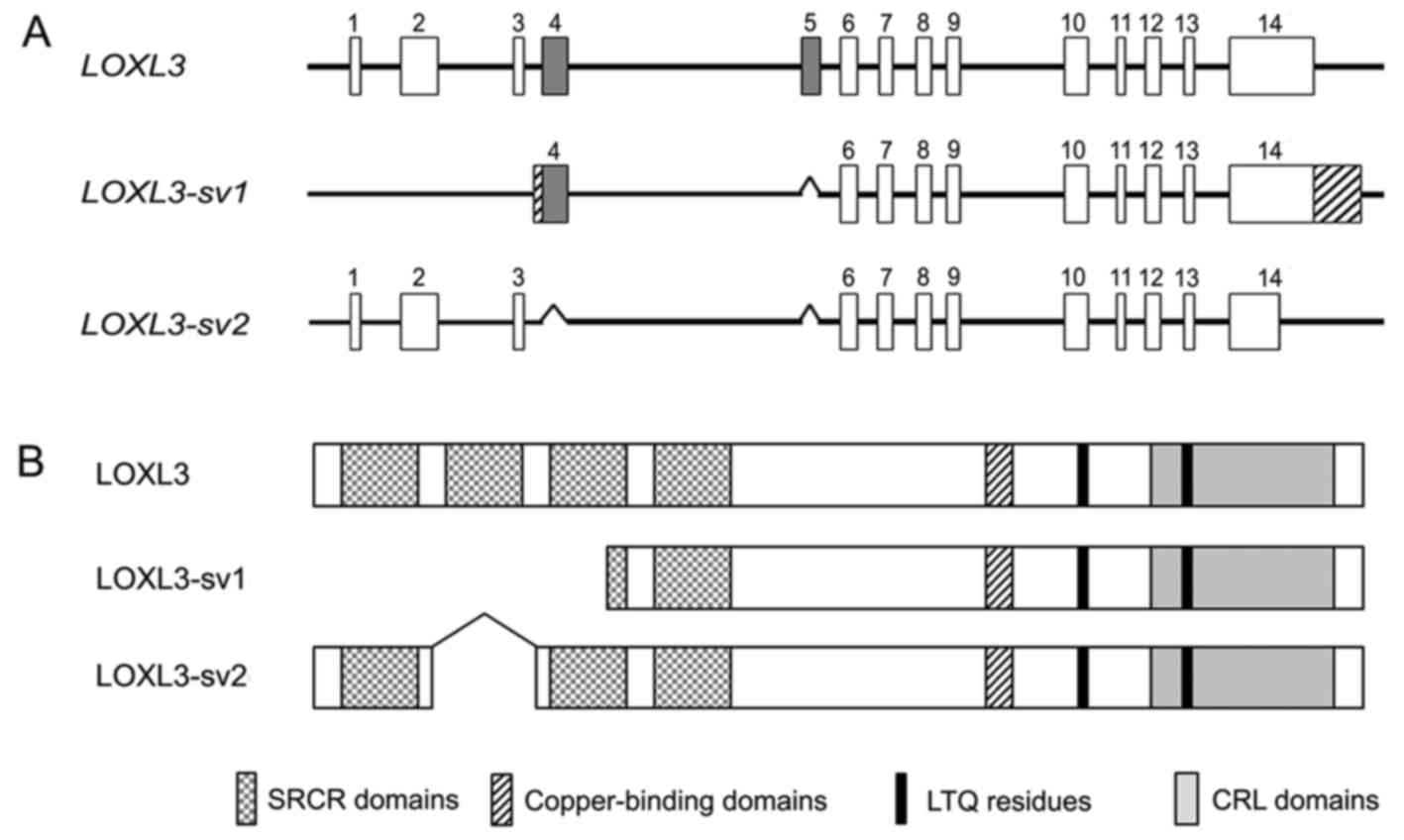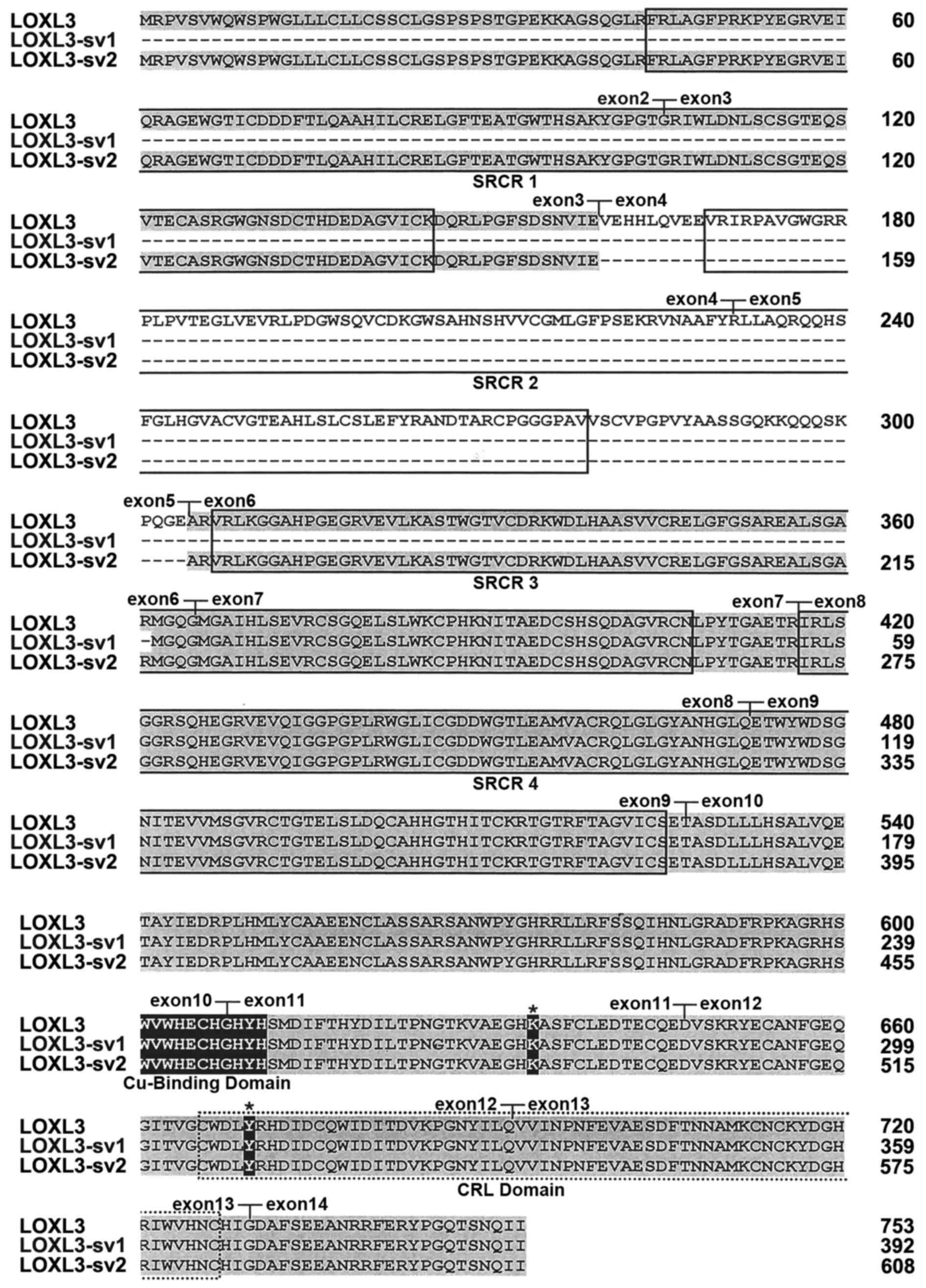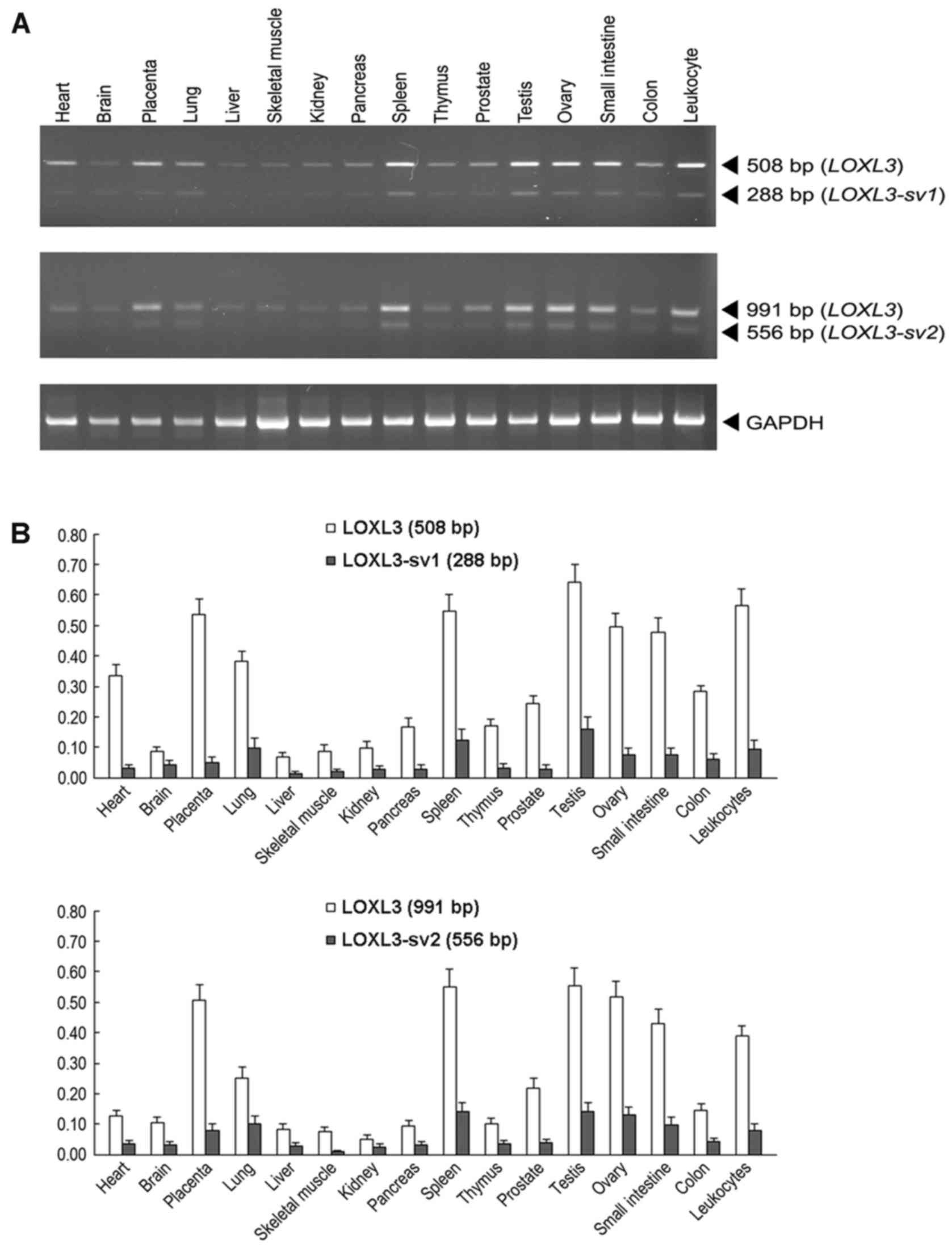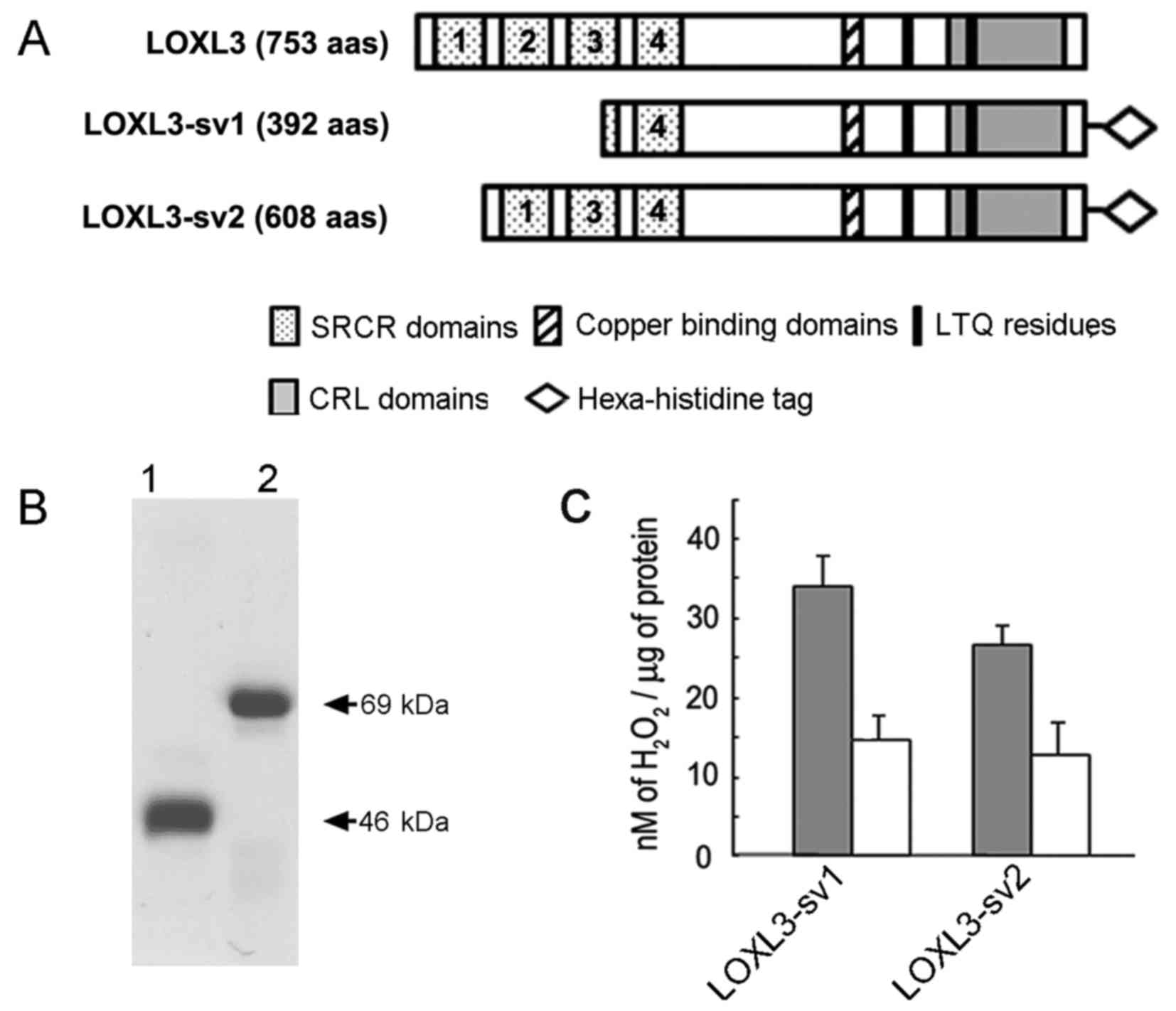LOXL3-sv2, a novel variant of human lysyl oxidase-like 3 (LOXL3), functions as an amine oxidase
- Authors:
- Published online on: January 19, 2017 https://doi.org/10.3892/ijmm.2017.2862
- Pages: 719-724
Abstract
Introduction
The human lysyl oxidase-like 3 (LOXL3) gene was originally identified by EST database searches, encoding a 753 amino acid-long polypeptide with a deduced molecular mass of 83 kDa (1,2). LOXL3 belongs to an emerging family of lysyl oxidases (LOX), each of which functions as a copper-dependent amine oxidase for the formation of lysine-derived cross-links found in collagen and elastin fibrils (3). All LOX paralogues (LOX, LOXL, LOXL2, LOXL3 and LOXL4) contain a copper-binding domain, residues for lysyl-tyrosyl quinone (LTQ) and a cytokine receptor-like (CRL) domain in the C-terminus. In addition, four repeated copies of scavenger receptor cysteine-rich (SRCR) domains are found in the N-terminus of only LOXL2, LOXL3 and LOXL4, suggesting novel functional roles assigned to these three members (4–6).
LOXL3 has been reported to be associated with a diverse range of diseases in both humans and animals. LOXL3 was reported to interact with Snail to downregulate the expression of E-cadherin in carcinoma progression (7), to induce the autophagy of chondrocytes in osteoarthritis (8) and to play an essential role in the regulation of integrin signaling for correct positioning and anchoring of myofibers (9). Expression of LOXL3 was found to be significantly reduced at both mRNA and protein levels in the vaginal tissues of patients with pelvic organ prolapse (10). A recent genetic study reported a homozygous missense mutation (C676Y) in LOXL3 as the cause of Stickler syndrome, a collagenopathy characterized by arthropathy and vitreoretinopathy with high myopia and cleft palate, in a consanguineous Saudi family (11). Several homozygous and compound heterozygous frame-shift mutations of LOXL3 have been identified in patients with early-onset high myopia (12). In animal studies, Loxl3−/− mice showed perinatal lethality with craniofacial and spinal defects (13), and knockdown of lox3b in zebrafish resulted in craniofacial abnormalities (14).
Previously, we reported a variant of LOXL3, termed LOXL3-sv1 (15), which contained the characteristic C-terminal domains of the LOX family but lacked the characteristic N-terminal region including SRCR domains 1–3. The LOXL3-sv1 showed amine oxidase activity toward different types of collagens with distinct substrate specificity from LOXL3 (15). In search of more human LOXL3 variants, we identified a novel variant, termed LOXL3-sv2, which lacked the sequences corresponding to exons 4 and 5 of LOXL3. The deduced amino acid sequence of LOXL3-sv2 does not have the SRCR domain 2 but contains all the other functional domains of LOXL3. The recombinant LOXL3-sv2 protein showed β-aminopropionitrile (BAPN)-inhibitable amine oxidase activity toward collagen type I. These findings indicate that LOXL3 encodes at least three variants, LOXL3, LOXL3-sv1 and LOXL3-sv2, each functioning as an amine oxidase toward collagen.
Materials and methods
EST database search
The human LOXL3 (GenBank accession no. NM_032603.3) cDNA sequence was used to search the human EST database through the BLASTN program (http://www.ncbi.nlm.nih.gov/cgi-bin/BLAST). EST clones showing significant sequence homology to human LOXL3 were purchased from GE Dharmacon (Lafayette, CO, USA) and were completely sequenced using an ABI 310 automated DNA sequencer.
RT-PCR analysis in human tissues
Human MTC (Multiple Tissue cDNA) Panels (Clontech Laboratories, Inc., Mountain View, CA, USA) were PCR-amplified with primers specific to LOXL3-sv1 (GenBank accession no. DQ378059) and LOXL3-sv2 (GenBank accession no. NM_001289164) using Ex-Taq polymerase (Takara Bio, Inc., Otsu, Japan). The LOXL3-sv1-specific primers were: forward, 5′-TGGAAGTCAGGCTTCCTGAC-3′ and reverse, 5′-CTCAGAGCTTCTCGAGCACT-3′. The LOXL3-sv2-specific primers were: 5′-GTGTGACTGAATGTGCCTCC-3′ and reverse, 5′-CAGTCATCCCCACAGATGAG-3′. Both the LOXL3-sv1-specific and LOXL3-sv2-specific primer sets were also designed to detect the LOXL3 mRNA. The PCR conditions consisted of 30 cycles at 94°C for 45 sec, 56–58°C for 45 sec, and 72°C for 45 sec with a predenaturation at 94°C for 5 min and a final extension at 72°C for 7 min. The amplified PCR products were analyzed by electrophoresis on a 2% agarose gel. GAPDH was used as an internal control. All RT-PCR analyses were performed in the linear range of amplification, and quantification was performed using Kodak Gel Logic Imaging System (Eastman Kodak, Rochester, NY, USA).
Expression and purification of the LOXL3-sv1 and LOXL3-sv2 proteins
For expression of the LOXL3-sv1 protein, the pET21-LOXL3-sv1 construct that was previously reported by us (15) was used. For expression of LOXL3-sv2, an EST clone (clone ID no. 6650423; GE Dharmacon) was used as a PCR template, and the entire coding region of LOXL3-sv2 was PCR-amplified by PfuTurbo™ DNA polymerase (Agilent Technologies, Santa Clara, CA, USA) according to the manufacturer's instructions. The sequences of the oligonucleotide primers used for the construction of the expression plasmids were 5′-GCGGCTAGCATGCGACCTGTCAGTGTCTG-3′ and 5′-GCGAAGCTTGATAATCTGGTTGCTGGTCTG-3′. A unique restriction site, either NheI or HindIII, was introduced in each primer for convenient subcloning into the pET21 vector. The PCR conditions consisted of 30 cycles at 94°C for 60 sec, 58°C for 60 sec and 72°C for 60 sec with a predenaturation at 94°C for 5 min and a final extension at 72°C for 7 min. The sequence of the resulting expression constructs was confi rmed by DNA-sequencing analysis using a Cycle Sequencing Ready Reaction kit (Life Technologies, Paisley, UK) according to the manufacturer's instructions. The Escherichia coli (E. coli) strain BL21 (DE3) (Novagen, Inc., Madison, WI, USA) was used for transformation of the LOXL3-sv1 or LOXL3-sv2 expression construct. The recombinant proteins were expressed, purified and refolded into an enzymatically active form as previously reported (15).
Amine oxidase assays
The amine oxidase activity of the LOXL3-sv1 and LOXL3-sv2 recombinant proteins were assessed using a peroxidase-coupled fluorometric assay with the Amplex® Red hydrogen peroxide assay kit (Molecular Probes, Eugene, OR, USA) as previously described (16). Each reaction contained 10 µg of the purified LOXL3-sv1 or LOXL3-sv2 recombinant protein and 20 pmol of calfskin type I collagen (Sigma-Aldrich, St. Louis, MO, USA) as a substrate in a reaction volume of 200 µl. Parallel assays were performed in the absence or presence of 1 mM BAPN for 30 min at 37°C. Fluorescence was measured using a fluorescence spectrophotometer (Molecular Devices, Sunnyvale, CA, USA) with excitation and emission wavelengths of 500 nm and 650 nm, respectively. Total amine oxidase activity was expressed as nM of H2O2 produced per µg of the LOXL3-sv1 or LOXL3-sv2 recombinant protein, calculated by interpolation with fluorescence values from an H2O2 calibration curve.
Statistical analysis
Statistical analyses were performed by means of one-way analysis of variance (ANOVA) followed by a multiple-comparison Tukey's test. All statistical analyses were performed using SPSS software version 12 (SPSS, Inc., Chicago, IL, USA). Statistical significance was determined at P-values <0.05.
Results
Distinct exon-intron structure of LOXL3-sv2 from LOXL3 and LOXL3-sv1
Searches for novel variants of the human LOXL3 gene resulted in the identification of ESTs (accession nos. EL736465 and CN422297) in the GenBank database, which showed a different exon-intron structure from LOXL3. Furthermore, this novel variant, termed LOXL3-sv2, showed an exon-intron structure distinct from the LOXL3-sv1 that we previously reported (15), lacking exons 4 and 5 of LOXL3 (Fig. 1A). The novel variant corresponded to the LOXL3 transcript variant 2 (LOXL3-v2) that was recently reported in the GenBank (accession no. NM_001289164). However, there was a difference in the length of the 3′-untranslated region (3′-UTR); our LOXL3-sv2 contains 476 bp 3′-UTR, whereas the previously reported LOXL3-v2 contains 1,348 bp 3′-UTR. LOXL3-sv2 also corresponded to an unverified cDNA sequence of LOXL3 (accession no. BC071865), but BC071865 contained an additional 30 bp sequence at the 5′-end, originating from an unknown source.
The LOXL3-sv2 mRNA is at least 2,398 bp in length, encoding a 608 amino acid-long polypeptide with a calculated molecular mass of 67.4 kDa. The deletion of exons 4 and 5 do not change the open-reading frame of LOXL3 but results in deletion of the SRCR domain 2 (Fig. 1B). The deduced amino acid sequence of LOXL3-sv2 contains the characteristic C-terminal domains of the LOX family, including the copper-binding domain, the residues for the LTQ cofactor, and the CRL domain (Fig. 2).
Expression analysis of LOXL3, LOXL3-sv1 and LOXL3-sv2 in human tissues
To compare the expression of LOXL3, LOXL3-sv1 and LOXL3-sv2 in human tissues, RT-PCR analyses were performed with poly(A)+ RNA isolated from 16 different human tissues. For specific detection of LOXL3-sv1 and LOXL3-sv2 amplicons, the different exonic structures of the LOXL3-sv1 and LOXL3-sv2 mRNAs were used to design the primers. Both the LOXL3-sv1- and LOXL3-sv2-specific primer sets were also expected to detect the LOXL3 mRNA that contains all the exonic sequences. For the LOXL3-sv1-specific amplicon, the forward primer was derived from exon 4, which was deleted in the LOXL3-sv2 mRNA, and the reverse primer was derived from exon 6. This primer set was expected to amplify a 288 bp band from nucleotide sequences 169–456 of LOXL3-sv1 and a 508 bp band from nucleotide sequences 638–1,145 from LOXL3. For the LOXL3-sv2-specific amplicon, the forward primer was derived from exon 3, which was deleted in the LOXL3-sv1 mRNA, and the reverse primers were derived from exon 8. This primer set was expected to amplify a 556 bp band from nucleotide sequences 460–1,015 of LOXL3-sv2 and a 991 bp band from nucleotide sequences 431–1,421 of LOXL3. In all tissues tested, amplicons of expected sizes were detected for both LOXL3-sv1 and LOXL3-sv2, but the expression levels were significantly lower than that of LOXL3 (Fig. 3). The expression patterns of LOXL3 and the two variants were similar in all tissues tested (Fig. 3).
Amine oxidase activity of LOXL3-sv2
We previously reported that LOXL3-sv1 functions as an amine oxidase (15). To determine if LOXL3-sv2 functions as an amine oxidase, we expressed and purified the LOXL3-sv2 protein in a hexa-histidine recombinant form as previously described for LOXL3 and LOXL3-sv1 (15). The LOXL3-sv1 protein was also expressed and purified in a hexa-histidine recombinant form for comparison of the amine oxidase activity with LOXL3-sv2 (Fig. 4A). However, the full-length LOXL3 protein was not expressed in the E. coli overexpression system, as we previously reported (15). It was probably due to the presence of rare codons clustered in the N-terminus of LOXL3, such as CCC (Pro11, Pro50, Pro53, Pro173, Pro181, Pro183 and Pro220) and AGG (Arg51, Arg192 and Arg224) that are infrequently used in E. coli. Clusters of rare codons were reported to reduce the expression level in E. coli (17). The apparent sizes of the purified recombinant proteins were in agreement with the deduced molecular mass; 46 and 69 kDa for the recombinant LOXL3-sv1 and LOXL3-sv2 proteins, respectively (Fig. 4B).
The recombinant LOXL3-sv1 and LOXL3-sv2 proteins were assessed for amine oxidase activity toward collagen type I using a peroxidase-coupled fluorometric assay. Both the recombinant LOXL3-sv1 and LOXL3-sv2 proteins showed significant levels of amine oxidase activity toward collagen type I in a manner sensitive to β-aminopropionitrile (BAPN), an irreversible inhibitor of the LOX-derived amine oxidase activity (Fig. 4C). The LOXL3-sv1 protein showed slightly higher amine oxidase activity than the LOXL3-sv2 protein; however, the difference was not statistically significant (Fig. 4C). These results indicate that LOXL3-sv2, as do LOXL3 and LOXL3-sv1, also functions as an amine oxidase toward collagen type I, a physiological substrate of the LOX family proteins.
Discussion
LOXL3-sv2, the newly identified variant of LOXL3, encodes a 608 amino acid-long polypeptide with a calculated molecular mass of 67.4 kDa. Previously, we reported an approximately 67 kDa protein in several human tissues using a polyclonal antibody against LOXL3 and proposed that the 67 kDa protein could be derived from post-translational modification of the full-length LOXL3 (15). However, judging from the deduced molecular mass of LOXL3-sv2, the previously reported 67 kDa band may correspond to a novel LOXL3-sv2 protein, although further detailed characterization is required. By promoter analysis, we previously demonstrated that an alternative promoter element present in the 5′-flanking intronic region of exon 4 of the LOXL3 gene regulates the transcriptional activation of LOXL3-sv1. The promoter region responsible for expression of the LOXL3 mRNA contained no TATA and CAAT boxes but abundant CpG-rich sequences, as shown in a number of eukaryotic housekeeping genes (18,19). In contrast, the LOXL3-sv1-specific promoter contained a TATA box with a number of potential transcription factor binding sites (15). The presence of exon 1 in the newly identified LOXL3-sv2 mRNA indicates that the promoter element located in the upstream region of exon 1 regulates the transcriptional activation of LOXL3-sv2. Identification of these LOXL3 variants suggest that at least three different regulatory mechanisms exist for the transcription of the LOXL3 gene, being responsible for the differential expression of LOXL3, LOXL3-sv1 and LOXL3-sv2.
The LOX family proteins have been proposed to exert different functional roles through distinct substrate specificity in the formation and maintenance of extracellular matrix. LOX and LOXL1 are more likely involved in the formation of fibrillar collagen fibers, such as types I-III, whereas LOXL2 is responsible for cross-linking of collagen type IV associated with the basement membranes (20). In peroxidase-coupled fluorometric assays with different types of collagens, LOXL3 showed higher amine oxidase activity toward collagen type I, II and VIII, whereas LOXL3-sv1 showed higher amine oxidase activity toward collagen types III and IV (15), further suggesting that the LOX family proteins may play different functional roles through distinct substrate specificity. In our amine oxidase assays, the recombinant LOXL3-sv2 protein showed a significant level of amine oxidase activity toward collagen type I in a BAPN-sensitive manner, indicating that LOXL3-sv2 functions as an active amine oxidase, although substrate specificity of LOXL3-sv2 has yet to be determined. Considering the diverse structural divergence and tissue distribution of different collagen types, detailed amine oxidase assays and colocalization studies with different types of collagens are required for further understanding of the functional significance of this novel LOXL3 variant.
LOXL3 contains four repeated copies of SRCR domains in the N-terminus, which are characterized by 6–8 cysteine residues in 90–110 amino acid long regions. SRCR domains are found either on the cell surface proteins or on secreted proteins, mediating protein-protein interactions for cell adhesion and cell signaling (21,22). The deduced amino acid sequence of LOXL3-sv2 shows deletion of the SRCR domain 2 but contains all the other SRCR domains as well as the characteristic C-terminal domains of the full-length LOXL3. In contrast, LOXL3-sv1 does not have the N-terminal SRCR domains 1–3 of LOXL3. Previously, using a series of deletion constructs of the N-terminal SRCR domains, we showed that the SRCR domains did not affect the amine oxidase activity of LOXL4, a close paralogue of LOXL3 (23). In this study, the purified recombinant proteins of both LOXL3-sv1 and LOXL3-sv2 showed BAPN-inhibitable amine oxidase activities toward collagen type I, further indicating that deletion of SRCR doma ins do not influence the amine oxidase activity at least in in vitro assays. Recently, LOXL2, another SRCR domain-containing LOX paralogue, was shown to affect keratinocyte differentiation through the SRCR domains but not by amine oxidase activity (24), suggesting unique functional roles of the SRCR domains present in the LOXL proteins. The partial absence of N-terminal SRCR domains in LOXL3-sv1 and LOXL3-sv2 suggests that these two variants may possess distinct interactive profiles from LOXL3 in protein-protein interactions. Further studies on the interactive properties of LOXL3, LOXL3-sv1 and LOXL3-sv2 will be important for understanding the functional differences of these three variants generated from the single gene in the biogenesis of extracellular matrix proteins.
Acknowledgments
This study was supported by the Basic Science Research Program through the National Research Foundation of Korea (NRF), funded by the Ministry of Education (no. NRF-2015R1D1A3A01016577).
References
|
Mäki JM and Kivirikko KI: Cloning and characterization of a fourth human lysyl oxidase isoenzyme. Biochem J. 355:381–387. 2001. View Article : Google Scholar : PubMed/NCBI | |
|
Jourdan-Le Saux C, Tomsche A, Ujfalusi A, Jia L and Csiszar K: Central nervous system, uterus, heart, and leukocyte expression of the LOXL3 gene, encoding a novel lysyl oxidase-like protein. Genomics. 74:211–218. 2001. View Article : Google Scholar : PubMed/NCBI | |
|
Smith-Mungo LI and Kagan HM: Lysyl oxidase: properties, regulation and multiple functions in biology. Matrix Biol. 16:387–398. 1998. View Article : Google Scholar : PubMed/NCBI | |
|
Kim Y, Boyd CD and Csiszar K: A new gene with sequence and structural similarity to the gene encoding human lysyl oxidase. J Biol Chem. 270:7176–7182. 1995. View Article : Google Scholar : PubMed/NCBI | |
|
Jourdan-Le Saux C, Tronecker H, Bogic L, Bryant-Greenwood GD, Boyd CD and Csiszar K: The LOXL2 gene encodes a new lysyl oxidase-like protein and is expr essed at high levels in reproductive tissues. J Biol Chem. 274:12939–12944. 1999. View Article : Google Scholar : PubMed/NCBI | |
|
Asuncion L, Fogelgren B, Fong KS, Fong SF, Kim Y and Csiszar K: A novel human lysyl oxidase-like gene (LOXL4) on chromosome 10q24 has an altered scavenger receptor cysteine rich domain. Matrix Biol. 20:487–491. 2001. View Article : Google Scholar : PubMed/NCBI | |
|
Peinado H, Del Carmen Iglesias-de la Cruz M, Olmeda D, Csiszar K, Fong KS, Vega S, Nieto MA, Cano A and Portillo F: A molecular role for lysyl oxidase-like 2 enzyme in snail regulation and tumor progression. EMBO J. 24:3446–3458. 2005. View Article : Google Scholar : PubMed/NCBI | |
|
Huang ZM, Du SH, Huang LG, Li JH, Xiao L and Tong P: Leptin promotes apoptosis and inhibits autophagy of chondrocytes through upregulating lysyl oxidase-like 3 during osteoarthritis pathogenesis. Osteoarthritis Cartilage. 24:1246–1253. 2016. View Article : Google Scholar : PubMed/NCBI | |
|
Kraft-Sheleg O, Zaffryar-Eilot S, Genin O, Yaseen W, Soueid-Baumgarten S, Kessler O, Smolkin T, Akiri G, Neufeld G, Cinnamon Y, et al: Localized LoxL3-dependent fibronectin oxidation regulates myofiber stretch and inte grin-mediated adhesion. Dev Cell. 36:550–561. 2016. View Article : Google Scholar : PubMed/NCBI | |
|
Alarab M, Bortolini MA, Drutz H, Lye S and Shynlova O: LOX family enzymes expression in vaginal tissue of premenopausal women with severe pelvic organ prolapse. Int Urogynecol J Pelvic Floor Dysfunct. 21:1397–1404. 2010. View Article : Google Scholar | |
|
Alzahrani F, Al Hazzaa SA, Tayeb H and Alkuraya FS: LOXL3, encoding lysyl oxidase-like 3, is mutated in a family with autosomal recessive Stickler syndrome. Hum Genet. 134:451–453. 2015. View Article : Google Scholar : PubMed/NCBI | |
|
Li J, Gao B, Xiao X, Li S, Jia X, Sun W, Guo X and Zhang Q: Exome sequencing identified null mutations in LOXL3 associated with early-onset high myopia. Mol Vis. 22:161–167. 2016.PubMed/NCBI | |
|
Zhang J, Yang R, Liu Z, Hou C, Zong W, Zhang A, Sun X and Gao J: Loss of lysyl oxidase-like 3 causes cleft palate and spinal deformity in mice. Hum Mol Genet. 24:6174–6185. 2015. View Article : Google Scholar : PubMed/NCBI | |
|
van Boxtel AL, Gansner JM, Hakvoort HW, Snell H, Legler J and Gitlin JD: Lysyl oxidase-like 3b is critical for cartilage maturation during zebrafish craniofacial development. Matrix Biol. 30:178–187. 2011. View Article : Google Scholar : PubMed/NCBI | |
|
Lee JE and Kim Y: A tissue-specific variant of the human lysyl oxidase-like protein 3 (LOXL3) functions as an amine oxidase with substrate specificity. J Biol Chem. 281:37282–37290. 2006. View Article : Google Scholar : PubMed/NCBI | |
|
Palamakumbura AH and Trackman PC: A fluorometric assay for detection of lysyl oxidase enzyme activity in biological samples. Anal Biochem. 300:245–251. 2002. View Article : Google Scholar : PubMed/NCBI | |
|
Jonasson P, Liljeqvist S, Nygren PA and Ståhl S: Genetic design for facilitated production and recovery of recombinant proteins in Escherichia coli. Biotechnol Appl Biochem. 35:91–105. 2002. View Article : Google Scholar : PubMed/NCBI | |
|
López-Maury L, Marguerat S and Bähler J: Tuning gene expression to changing environments: from rapid responses to evolutionary adaptation. Nat Rev Genet. 9:583–593. 2008. View Article : Google Scholar : PubMed/NCBI | |
|
Yang C, Bolotin E, Jiang T, Sladek FM and Martinez E: Prevalence of the initiator over the TATA box in human and yeast genes and identification of DNA motifs enriched in human TATA-less core promoters. Gene. 389:52–65. 2007. View Article : Google Scholar : | |
|
Csiszar K: Lysyl oxidases: a novel multifunctional amine oxidase family. Prog Nucleic Acid Res Mol Biol. 70:1–32. 2001. View Article : Google Scholar : PubMed/NCBI | |
|
Martínez VG, Moestrup SK, Holmskov U, Mollenhauer J and Lozano F: The conserved scavenger receptor cysteine-rich superfamily in therapy and diagnosis. Pharmacol Rev. 63:967–1000. 2011. View Article : Google Scholar : PubMed/NCBI | |
|
Bowdish DM and Gordon S: Conserved domains of the class A scavenger receptors: evolution and function. Immunol Rev. 227:19–31. 2009. View Article : Google Scholar : PubMed/NCBI | |
|
Kim MS, Kim SS, Jung ST, Park JY, Yoo HW, Ko J, Csiszar K, Choi SY and Kim Y: Expression and purification of enzymatically active forms of the human lysyl oxidase-like protein 4. J Biol Chem. 278:52071–52074. 2003. View Article : Google Scholar : PubMed/NCBI | |
|
Lugassy J, Zaffryar-Eilot S, Soueid S, Mordoviz A, Smith V, Kessler O and Neufeld G: The enzymatic activity of lysyl oxidas-like-2 (LOXL2) is not required for LOXL2-induced inhibition of keratinocyte differentiation. J Biol Chem. 287:3541–3549. 2012. View Article : Google Scholar : |













